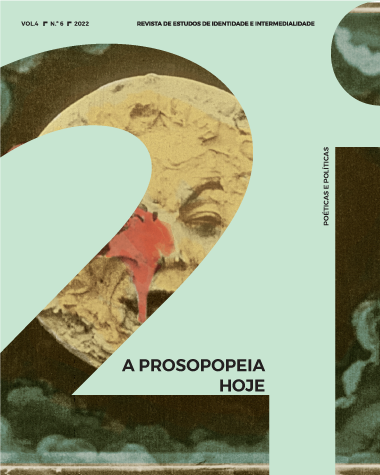
PROSOPOPOEIA TODAY: POETICS AND POLITICS
2i | JOURNAL OF IDENTITY AND INTERMEDIALITY STUDIES
issue 6 (2022)
Deadline for submissions of contributions: 15 July
Editors: Amândio Reis (U. Lisbon) and José Bértolo (NOVA U. Lisbon)
In the original sense, as a figure of rhetoric, prosopopoeia consists in “putting speech into the mouths of others”. Therefore, Quintilian defines it as a resource that allows us to “present the intimate thoughts of our adversaries as if they were speaking to themselves” (Institutio Oratoria IX: 2, 29-32). As such, be it a gift or an imposition of discourse, and even if guided by verisimilitude, prosopopoeia often brings into play a crisis of identity, a challenge to the precepts of realistic representation, and the materialization in language of a “natural impossibility” (Riffaterre 1985: 110).
The majority of conceptual definitions of prosopopoeia describe it as an attribution of life to the inanimate and/or of expression to the ineloquent, making it the key figure in the creation of fictional characters. Therefore, all acts associated with fiction and representation are somehow linked to the phenomenon of prosopopoeia. However, in a more precise usage, this figure tends to be associated mainly with personification, i.e., the attribution of human faculties to non-human objects or beings. In short, prosopopoeia utilizes language “to give a name, a face, or a voice to something that does not possess them” (Miller 2016: 107).
In literary history and criticism, prosopopoeia plays a discreet but important role. Fables, for example, are based on anthropomorphism; and Gothic literature offers a vast gallery of painted characters who free themselves from their frames, sculptures that come to life, or automata, of which Der Sandmann, by E.T.A. Hoffmann, is a major example, inspiring Sigmund Freud to conceive of the Unheimliche as a form of familiarity in strangeness.
But apart from its roots in rhetoric and literature, prosopopoeia extends into other arts. In the history of painting, there are frequent depictions of it, going back, for example, to the Ovidian episode of Galatea’s metamorphosis from ivory to flesh and blood by artists such as Edward Burne-Jones or Jean-Léon Gérôme. In cinema, prosopopoeia can be analyzed from a thematic — with ghost stories, automata, talking animals, robots — as well as a theoretical point of view. Several thinkers have endowed the camera with human qualities by describing it as a “cine-eye” (D. Vertov) and attributing to it “a machinic intelligence” (J. Epstein), that is, a form of subjectivity and consciousness. And cinema often shows subjective shots giving access to the point of view of non-human beings and inanimate objects (the donkey in Robert Bresson’s Au hasard Balthazar, or the doll in Manoel de Oliveira’s Aniki Bobó). Moreover, given the nature of the medium, by associating images with words, or faces with speech, and its intrinsic relationship with ghosts and spectrality, cinema is especially suited to prosopopoeia as the “fiction of an apostrophe to an absent, dead, or voiceless entity, offering it the possibility of a response and conferring upon it the gift of the word” (De Man 1984: 77).
Since antiquity, but particularly in the multimedia context of today, in which it finds new functions and possibilities, prosopopoeia also serves poetic and political purposes. Along with studies in narratology and stylistics, animal studies, ecocriticism, posthumanism and thing theory have shown a growing interest in questioning anthropocentric conceptions of life and art, placing the non-human at the heart of inquiries and giving it a face and a voice. This issue of 2i intends to reevaluate conceptualizations and uses of prosopopoeia across the arts, throughout history, and in interdisciplinary contexts.
Some of the topics we hope to explore in this issue include:
· Prosopopoeia and other figures of rhetoric (personification, apostrophe, allegory, dialogism, hypotyposis, ethopoeia);
· Fiction, narrative and embodiments of prosopopoeia: sculptures, portraits, automata, ghosts, deities and supernatural entities;
· Prosopopoeia and the Unheimliche;
· Prosopopoeia and death: spectrality and the ghostly;
· Prosopopoeia, dreams, hallucination and surrealism;
· Puppetry, ventriloquism and the mask;
· Prosopopoeia, description and allegory (landscapes, objects, abstractions);
· Theory of genres: horror, fairy tale, fable, science fiction, epitaph;
· Prosopopoeia as a challenge to anthropocentrism: animal studies, ecocriticism, posthumanism;
· Magic, animism, hierophany, possession;
· Prosopopoeia in the Anthropocene: the “life” of mineral and geological elements;
· Prosopopeic metaphors in thinking about art (the eye of the camera, the muteness or eloquence of the paper, the corporeality of the stone, etc.);
· “Thing theory” and the life of objects.
Articles may be written in Portuguese, English, French, or Spanish.
Works cited:
De Man, Paul (1984). The Rhetoric of Romanticism. New York: Columbia UP.
Epstein, Jean (2014). Écrits complets, Volume V, 1945-1951: L’Intelligence d’une machine, Le Cinéma du Diable et autres écrits. Paris: Independencia Éditions.
Miller, J. Hillis (2016). Western Theories of Poetry: Reading Wallace Stevens’s “The Motive for Metaphor”. In Ranjan Ghosh & J. Hillis Miller, Thinking Literature across Continents. Durham and London: Duke UP.
Quintilianus, M.F. (1959). The Institutio Oratoria, edited and translated by H.E. Butler. Cambridge: Harvard UP, The Loeb Classical Library.
Riffaterre, Michael (1985). Prosopopeia, Yale French Studies, No. 69, pp. 107-123.
Vertov, Dziga (1984). Kino-Eye: The Writings of Dziga Vertov, edited by Annette Michelson and translated by Kevin O’Brien. Berkeley/Los Angeles/London: U California Press.